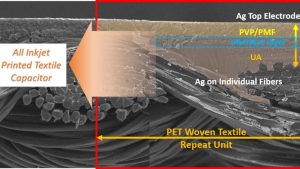In a new study, North Carolina State University researchers demonstrated they could print layers of electrically conductive ink on polyester fabric to make an e-textile that could be used in the design of future wearable devices.
Since the printing method can be completed at room temperature and in normal atmospheric conditions, researchers believe inkjet printing could offer a simpler and more effective method of manufacturing electronic textiles, also known as e-textiles. In addition, researchers said the findings suggest they could extend techniques common in the flexible electronic industry to textile manufacturing. They reported their findings in the journal ACS Applied Materials & Interfaces.
“Inkjet printing is a rapidly advancing new technology that’s used in flexible electronics to make films used in cellphone displays and other devices,” said the study’s corresponding author Jesse S. Jur, professor of textile engineering, chemistry and science at NC State. “We think this printing method, which uses materials and processes that are common in both the electronics and textiles industries, also shows promise for making e-textiles for wearable devices.”
In the study, researchers described how they used a FUJIFILM Dimatix inkjet printer to create a durable and flexible e-textile material, what they did to reliably create the e-textile, and its properties. Part of their challenge was to find the right composition of materials so the liquid ink would not seep through the porous surface of the textile materials and lose its ability to conduct electricity.
“Printing e-textiles has been a very big challenge for the e-textile industry,” said the study’s first author Inhwan Kim, a former graduate student at NC State. “We wanted to build a structure layer by layer, which has not been done on a textile layer with inkjet printing. It was a big struggle for us to find the right material composition.”
They created the e-textile by printing layers of electrically conductive silver ink like a sandwich around layers of two liquid materials, which acted as insulators. They printed those sandwich layers on top of a woven polyester fabric. After they printed the layers of silver ink and insulating materials — made of urethane-acrylate, and poly(4-vinylphenol) –— they monitored the surface of the material using a microscope. They found that the chemical properties of the insulating materials, as well as of the textile yarns, were important to maintaining the ability of the liquid silver ink to conduct electricity, and prevent it from penetrating through the porous fabric.
“We wanted a robust insulation layer in the middle, but we wanted to keep it as thin as possible to have the entire structure thin, and have the electric performance as high as possible,” Kim said. “Also, if they are too bulky, people will not want to wear them.”
The researchers evaluated the electrical performance of the e-textile after they bent the material multiple times. They tested more than 100 cycles of bending, finding the e-textile didn’t lose its electrical performance. In future work, they want to improve the materials’ electrical performance compared to e-textiles created using methods that require special facilities and atmospheric conditions, as well as increase the material’s breathability.
Eventually, they want to use the printing method to create an e-textile that could be used in wearable electronics such as biomedical devices that could track heart rate, or used as a battery to store power for electronic devices.
“We were able to coat the ink on the fabric in a multi-layer material that’s both durable and flexible,” Kim said. “The beauty of this is, we did everything with an inkjet printer – we didn’t use any lamination or other methodologies.”
The study, “Microstructures in All-Inkjet Printed Textile Capacitors with Bilayer Interfaces of Polymer Dielectrics and Metal-Organic Decomposition Silver Electrodes” was published online in ACS Applied Materials & Interfaces. In addition to Jur and Kim, the other authors were Beomjun Ju, Ying Zhou and Braden Li. It was funded by VF Corp. The authors also acknowledge Liquid X Printed Metals for the preparation of the reactive silver inks used in this study. The authors acknowledge the U.S. Department of Defense and the Air Force Research Laboratory for provision of the Science Mathematics and Research for Transformation (SMART) scholarship to Li. This work was supported by the National Science Foundation through Nanosystems Engineering Research Center for Advanced Self Powered Systems for Integrated Sensors and Technologies under Grant EEC 1160483.
Editor’s Note: Laura Oleniacz is Public Communications Specialist at NC State News Services.
June 16, 2021





